My experience with Burn Bryte (Why you should try it!)
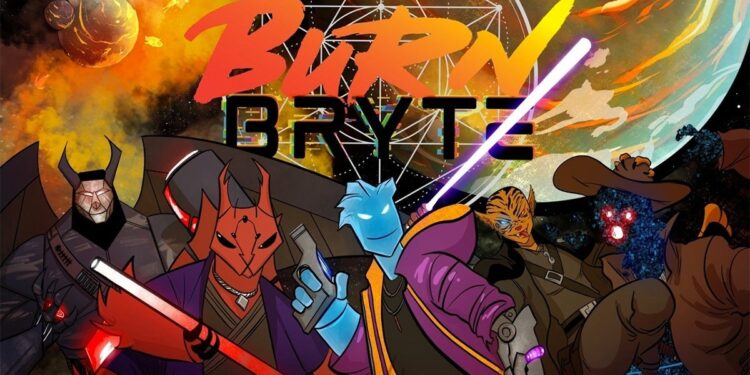
All images were taken from the Burn Bryte RPG
So far I got to play about 6 games of Burn Bryte. I’ve already been on both sides of the “screen”. I say it like this because there isn’t an actual GM screen in this game, but a digital one. It was created to be run via Roll20, and takes huge advantage of its tools. It is only right now that I believe I have enough experience with the game for me to properly write about all its amazing things. There are still some things I didn’t manage to test, but I will someday. For now, let’s take a look at the things I loved about this game!
A brief idea on what Burn Bryte actually is
The best way for me to describe this game is a mixture between Guardians of the Galaxy, Firefly, Blade Runner, and a bit of Animal Crossing (that last one was weird, right?). You play as a group of well-intentioned adventurers in this apocalyptic world slowly falling to its demise. The weird thing about this (which is something I love) is that none of the playable species is a human. You’ve got cat-folk that are usually extremely agile and great deceivers, floating octopus-like creatures of light that get their energy from a crystal, literal mechs that can transform into turrets and carry allies inside of them, slugs that can possess corpses by getting inside them, and many others, most of these being very cool bug creatures. They even had people that study bugs working in the design of the game!
The galaxy you get to play in is Olaxis, one that is completely surrounded by a weird phenomenon named the Burn because of the way it looks. No one knows what happens when one enters in contact with the Burn, but nothing that touches it ever comes back. Cultists have begun to adore it, scientists to investigate what to do with it, and commonfolk are panicking as the burn closes in devouring entire planets. Nevertheless, the speed the Burn travels at changes all the time, so there is no way to know if the galaxy will cease existing in a few weeks or in millennia. In this apocalyptic world, you play the heroes that help those in need doing all sorts of missions.
You play the hero
Even though you could actually play more of a mercenary space gang, this ruleset was intended to have the characters do heroic actions, and the game primarily revolves both around that and teamwork with your party members. The game mechanics were created so there is a high chance you accomplish anything you set your mind to. This is achieved by the Push your Luck system that the game provides and revolves around.
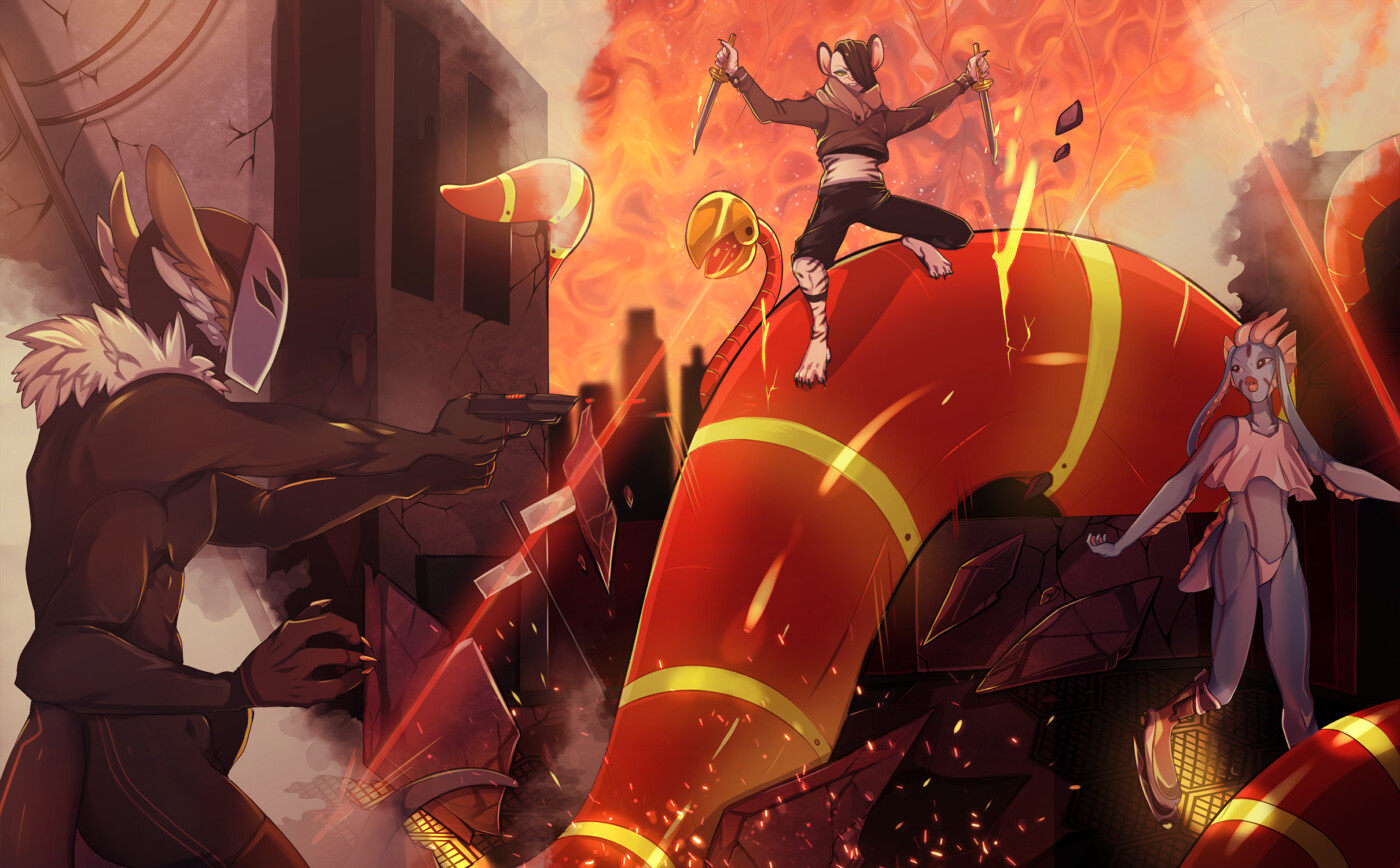
Mechanics
Skill System
Burn Bryte revolves all around its skill system. These are divided in Mental, Physical and Social. In a way, the game consists of bluffing your way convincing your GM on why it makes sense that a certain skill allows you to do a certain action. In combat, you use these skills as well. For example, you might use Ranged to shoot your rifle, but maybe using Athletics to shoot because you are dealing with the recoil of the weapon makes sense as well. Deceive or Presence can also be used to attack by intimidating the enemy, for example, as you are reducing the enemy’s morale, which reduces their hit points (or as they are called in this game: Health Levels). Having both combat and usual skill checks use the skill system forces the players to be creative. But how is it that the game manages to have the players use different skills instead of only the ones they are good at?
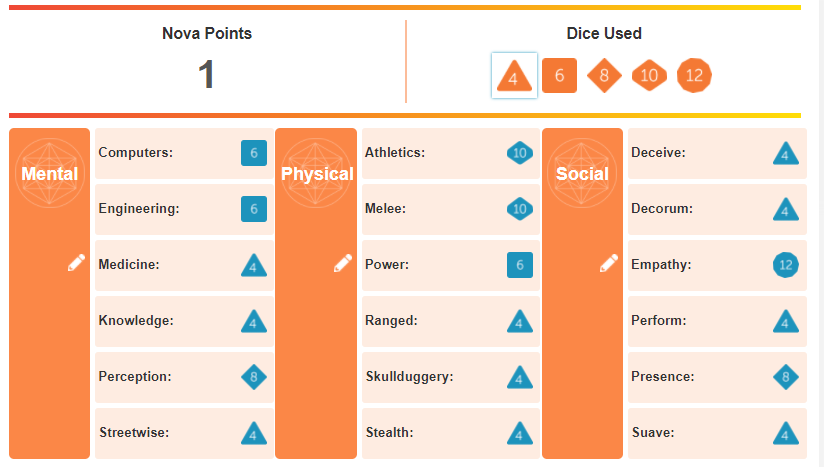
Skill section in the character sheet
Push Your Luck
The Push Your Luck system in this game works due to a combination of many things. There is something called Nova Abilities in this game that are pretty much ultimate abilities (more on that below). The way for you to use Nova Abilities is by spending Nova Points. You get these points by using each die once like in the image above. Let’s say you use Empathy to convince a guard to let you enter a secret club. Even if you failed the skill check you mark the d12 as a die used in the “Dice used” section. Once you use all once you reset that section and give yourself a Nova Point. It is because of this that the game forces you to try out even your weaker skills. You may not be good at Stealth, but if you want that Nova Point you might have to take the risk!
How do skill checks work, and how do they implement a Push your Luck system? Out of combat, a skill check has a complexity determined by the GM. If achieving something is complexity 3 then you have to roll as many dice from the skill you chose as the complexity (if you chose Power you would roll 3d6 as the complexity was 3). In order to succeed you have to avoid getting doubles in the dice rolled. This means that the lower the die the higher the chance of rolling doubles. In combat, on the other hand, you can do as many actions as you want per turn until you fail or decide to stop. Your first action is always complexity 2, your second one is complexity 3, the third 4, and so on. You can stop your turn at any time, or keep going until you fail. That’s where the game gets amazing in my opinion. Failing gives Collapse Points to the GM, which is something they can use to have enemies use special abilities or attack again.
Let’s take a step back and look at all of this with the game designer hat on. The game wants you to push your luck to do more stuff on your turn, starting at a low complexity but increasing for each action you succeed in. The skill system combined with the Nova Points has you want to use skills you are not particularly great at. This means that the system rewards creativity and doing weird stuff by trying all sorts of skills, at the same time it leaves you wanting to push your luck to make more actions in your turn. That’s brilliant design! I can assure you I’ve seen players do stuff in Burn Bryte I might never get to see in other games.
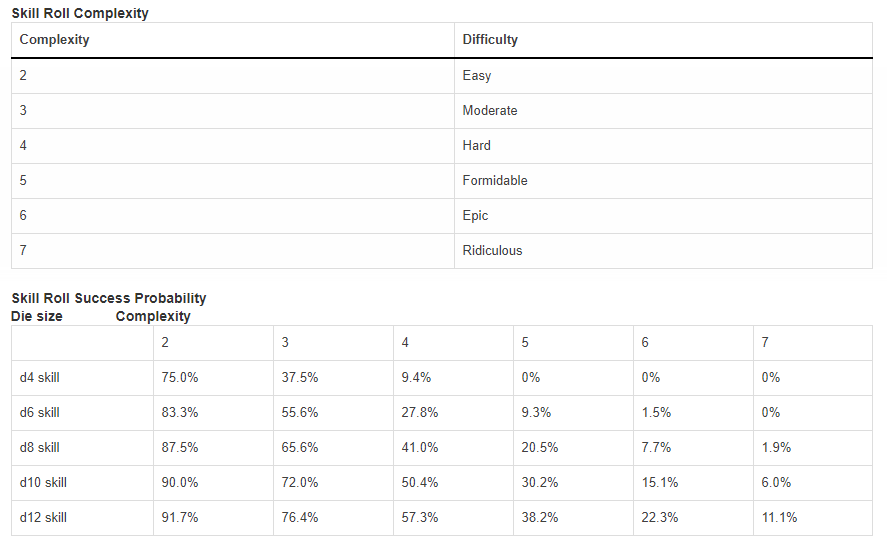
Stats found in the rules for all you stats nerds
Nova Abilities and Special Abilities
Burn Bryte doesn’t have a class and race system. By having all species living in Olaxis be completely different from each other, their bodies allow for lots of different abilities each. The mech-like species can implement thrusters on itself to fly, but the giant beetle warriors can grow wings to fly as well, for example. This allows for shared abilities achieved through different means that have something to do with the species you are playing. Of course, most abilities aren’t repeated making each species their own. The way you earn these different abilities is by progressing in a skill leveling system called the Story Path. This means that even if two players played the same species, they could both get different special abilities and nova abilities making both characters completely unique.
What makes Nova Abilities and Special Abilities different then? Nova abilities are usually extremely powerful having your character do amazing things at the cost of a Nova Point. Special Abilities, on the other hand, are usually free to use and
Story Path
The story path is the progression system this game uses. You choose one of the many options for you to choose, which are long-term objectives such as making a big discovery, getting a mentor, survive in a desolated place, falling into temptation, and many others. There are lots of objectives, all with predefined milestones to complete them. Each separate milestone gives you something for your character, be it a skill improvement, a special ability, or some other thing. This allows players to focus mostly in the story they are playing and not in killing several baddies for experience points. Once you complete your story path you usually gain something special and you get to choose another one! Your story path usually leaves you with a clear path ahead of you, making it easy to choose which story path to follow next. If you don’t want to, just pick another one!
From a GM perspective, story paths make game prepping much easier! You already know what all players are looking forward to doing with their characters. It’s right there in their character sheets! You just need to have one of their milestones appear in the session and tie the milestones of all characters together into something that makes sense in the story you are telling. You literally are building a story around what your players want to do.
Combat
If there is one thing I love the most about this game is its initiative system. This one is divided into three phases. In the first one, the GM uses the token markers to mark the enemies and the PCs these enemies are planning to attack. In phase 2, players need to plan how they plan to act and take turns in the order they decide (last time I ran the game I misinterpreted the rules and ran it wrongly making the combat a bit of a slog. Luckily, James confirmed my mistake over on Twitter. Take a look at it so you don’t make the same mistake I did). When run correctly, combat goes extremely smooth and fast-paced. Players are encouraged to use one of their many actions they can use per turn to dodge the attacks declared in phase 1, making the combat feel more swashbuckler. Then, in phase 3 the actions declared in phase 1 transpire, and the initiative round starts again.
Most weapons in the game deal between 1 and 2 damage, and the amount of health levels that each PC has is no bigger than 5. This means that player characters really need to avoid any sort of damage, or they might easily fall in battle. This creates a very heroic and swashbuckley sort of playstyle, avoiding all shots and defeating your enemies in clever imaginative ways. I’ve had players surf over a spaceship being hacked by another to fastly approach an enemy and hit it with a power staff. One of the mech-dudes (officially called peacecrafts) even punched a car hulk style towards an enemy. Those are the kinds of things that I love about this game that are difficult to replicate in others.
Your Spaceship
There’s only one thing I never managed to try out yet and that’s space combat. However, I can pretty much talk about all the other stuff about it.
The party shares one single spaceship in a Firefly sort of way. As you progress you can add more weapons, computers, and commodities to your ship, adding them in the same way you do when decorating your house in the Sims or Animal Crossing. Now, what’s interesting about this is that you should position everything strategically because of the way spaceship combat works. In other words, if you are like me, you will try to aesthetically position everything so that it looks nice while also having everything be in the best position possible in the case combat ensues.
As regards how the combat transpires, this uses a very similar system to the Circle Method I explain in my Theatre of the Mind article. As you can see in the image below there are several sections the enemies could be located in that allows for a very easy way to manage combat without having to move the elements added to the ship constantly. This means that when you veer the ship anticlockwise you move all enemies in a clockwise manner instead of moving the ship in the map. When firing the ship, maneuvering, or doing different stuff with the ship in the middle of combat you have to move your character like in normal combat inside the ship going from one laser cannon to the helm. That’s why positioning and teamwork are vital. If you played the videogame Faster Than Light, I can imagine the devs have taken some ideas from it.
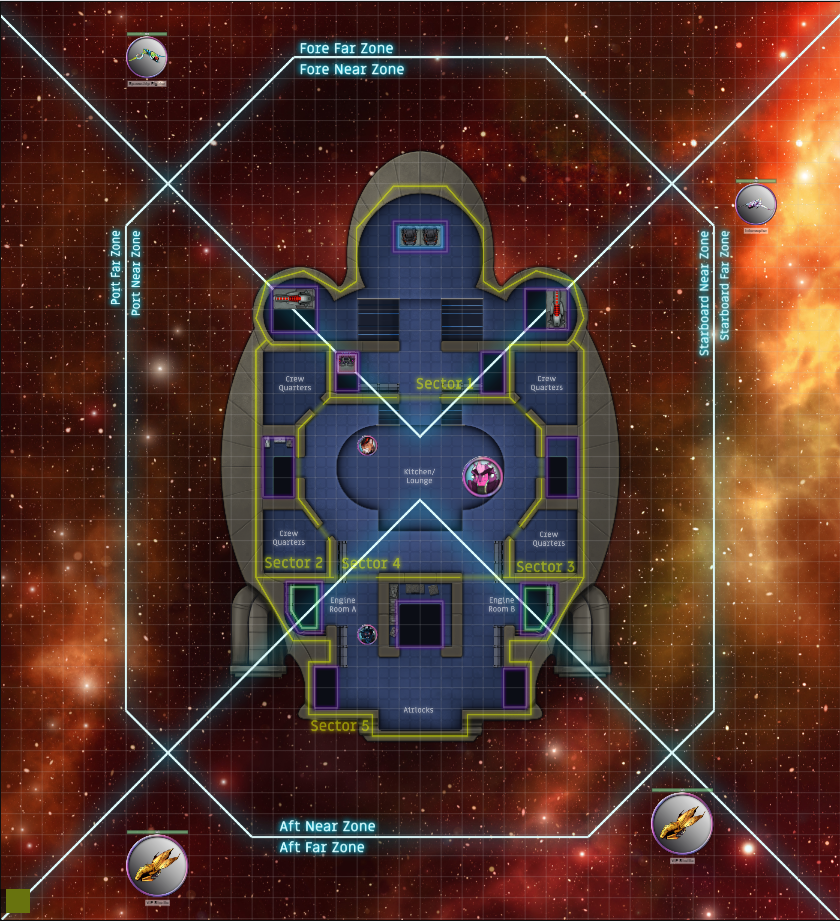
Spaceship Interior & Combat
Crafting a great story
The way all about the game of Burn Bryte revolves around creating a great narrative is definitely what I like the most about the game. Killing and looting is not the way forward like in other games. The combat system has you thinking out of the box to create weird results that will have each game feel different. The story path system marks a path that leads towards a great story your players want to see happen. It definitely feels as if it was created to be heavily story-driven.
Content
Besides the official ruleset, you can also get the Burning Daylight adventure, which includes all you need to play. If I haven’t fully convinced you by this point to try out the game, consider getting this adventure, which is at a much lower price than the rules and has everything you need to get started playing: pregen characters, handouts, a full adventure that you should be able to play in 1-3 sessions, quickstart rules, and an open ending that gives the GM a chance to continue the story with adventures of their own! All people I got to play this with had a ton of fun and have very different results due to the game’s flexibility.
If you are looking to run your own adventures in Olaxis, I recommend getting the Starter Bundle, which comes with everything I indicated before, and a whole load of map tiles to create your own battlegrounds. Even if you don’t use them for Burn Bryte, these are modular enough that you can use them for any sci-fi game!
The game keeps receiving content after its launch last year, getting official add-ons, and 2 official adventures so far. Expect to see more content from them soon!
Conclusion
If you are looking for a new game to try out after getting burned out in the campaign you are running, consider giving this game a try. I’m definitely looking forward to playing more adventures in Olaxis. The flexibility and mechanics this game has to offer makes it completely unique, and a game I definitely recommend if you are looking for an action-packed story-driven sci-fi game.
If you liked this
Are you looking for more of a horror single-player game? Here I leave you a recommendation about The Wretched, a game set in a spaceship in a similar situation to the first Alien movie: CLICK HERE


